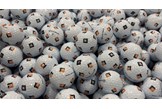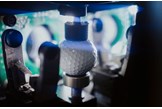How do TaylorMade make golf balls?
Published: Last updated:
How do TaylorMade make golf balls? With the brand’s Liberty, South Carolina golf plant producing nearly 3 million dozen urethane-covered balls a year, I went to see how they do it…
It’s hard to believe today, but before 2006 TaylorMade had never made a tour-level urethane-covered golf ball (revered to be the make-up of the best golf balls available). Back then the brand tiptoed quietly into the premium golf ball market with barely a whisper. Sergio Garcia and Justin Rose might have played the new TP Red and TP Black, but at the time, the suits at TM were more concerned about protecting their ‘#1 driver in golf’ status rather than investing big style into golf balls.
The TP balls were good, as were the subsequent Penta. Yet Adidas who owned the company back then were extremely reluctant to spend on developing the brand’s golf ball business. And if you’re going to stand a chance of taking on the mighty Titleist Pro V1 you need seriously deep pockets to make an impact and grab market share.
It wasn’t until 2017 and the launch of the TP5 and TP5x with a new five-layer construction that TaylorMade started taking golf balls seriously. They’d spotted that to be a sustainable business they needed to rely on more than just brilliant driver sales every year to pay the bills. And with golf being unable to be played without one, balls are an incredibly good way to keep money flowing when retailers are focused on clearing out your latest driver at bargain basement prices.
Since seeing success with the TP5 and TP5x, thanks to Rory McIlroy, Dustin Johnson, Collin Morikawa, and Tommy Fleetwood all playing the models, the company has gone out of its way to realign itself as a golf ball company.
Mike Fox, Senior Director of Product Creation for Golf Ball told me: “Back in 2006 we made some great golf balls, but nobody knew we made great golf balls. We ranked as the 6th biggest global golf ball producer, now in 2023 we stand at 15-16% market share in the USA and 18% in Europe with our eyes set on closing the gap to the #2 position. We believe when golfers now think of TaylorMade they think just as much about our golf balls as they do our clubs”.
Since 2017, and thanks to new more ambitious owners, the brand has invested over $100 million in their golf ball business. The Liberty golf ball plant in South Carolina has been extended multiple times and having bought two previous suppliers in Taiwan and Korea, the company can today proudly say every urethane-covered TaylorMade ball produced is made in the USA. But where some would see a $100 million investment as the finish line the company swears they’re only just getting started.
It’s taken a lot of hard work and a ton of know-how to figure out how to print 360° precisely and consistently around a golf ball’s surface, something competitors have yet to fathom at a serious scale. But, with sales of visual tech as well as colored and customized golf balls rising from 5% to 50% over the last five years the brand is confident they’re standing on the cusp of a new personalized golf ball wave which is set to redefine the market.
By spending just as much on golf balls over the next five years as they have done over the last five, TM’s plan is to attach emotion to buying golf balls. So in the same way we love choosing personal headcovers, putters and driver shafts that mean something to us, we’ll all have the same opportunity with golf balls, no matter what our budget.
In the year TaylorMade is going all guns blazing at golf ball visual tech and personalization, I made the journey to the super secretive Liberty, South Carolina Golf Ball Plant to see how the best TaylorMade golf balls are made.
How TaylorMade makes urethane-covered golf balls
It all starts with the core
All of the compression molded rubber cores inside the TP5, TP5x, and Tour Response are produced in Asia by TaylorMade-owned facilities. Each is a different color so there’s never any confusion over which core should be inside which ball. The cores are shipped to Liberty before being put through a stringent QC check. Any that don’t hit the company parameters at this stage will be out of spec at the end of the line.
Before production starts every core has to be chilled below 15.5° and at a very tight humidity tolerance, or else the finished ball will be out of size or weight. Sometimes in the South Carolina heat, it can take up to 8 hours to get a hopper full of cores to this limit. They then need to be kept there until the production line is ready for them.
Get in the molding line
Once the cores are at the right temperature and humidity, a good bond between them the mantle layer and cover is guaranteed. This part of the process is highly automated but a squirt of urethane is directed into a muffin tray-type mold with the balls dimple pattern milled inside before the core is gently squashed into the mixture.
Only half the ball is done at one time, so the half-finished ball has to be flipped over and the process repeated. With urethane setting in 45 seconds, the machinery has to be quick, precise, and consistent if it’s to churn out 40 balls or 80 separate halves a minute.
Inside, the machine uses Artificial Intelligence to check 30 different attributes and parameters as each ball is baked and then buffed to remove the Saturn-type ring around its equator. A lap around the core molding line takes between 12-15 minutes where cores go in before seamless golf balls are spat out.
Prep that surface
It’s really odd to see thousands of golf balls without any paint or logo, but TaylorMade keeps a very close eye on every batch thanks to a QR code on the side of every hopper. Try to move one to a station it’s not expecting, and it will immediately hit the brakes and stop itself from being moved.
The ball now has its cover but thanks to using a realising agent inside each mould to allow finished balls to drop out easily the surface is very slick. The surface prep room buffs the unfinished ball to prepare it for a paint job.
The paint job
Painting thousands and thousands of golf balls a day reliably and consistently while ensuring there’s zero pooling in the dimples to compromise the ball’s aerodynamic package is a big ask that could never be left to the human hand. Robots and machines load each ball onto a paint line which automatically spins them around at a consistent speed to ensure the equator gets the same amount of paint coverage from a static spray gun as the axis at the top and bottom.
Up until this point, apart from the five-layer construction of the TP5 and TP5x, there’s nothing too different to how other leading golf ball manufacturers make cast urethane cover golf balls. From here on in though it’s a whole different ball game when it comes to giving TaylorMade balls their identifying name, numbers, and personality.
Finishing
TaylorMade are incredibly protective over how they print golf balls, the machines they use and the technology they’ve had to develop to get them to produce golf balls in the way they need just can’t be bought off the shelf. And they know their competitors are watching at every opportunity, so while we were allowed to view how it was done, we were not allowed to film or photograph parts of the process.
Essentially a robot is constantly loading the machine with fresh balls as each batch is completed. Balls make their way through the machine and a combination of hi-tech camera technology and deep AI learning position each ball precisely before it is stamped and rotated. Only one color in a single location can be printed at a time so for a pattern as complex as the Pix 3.0 found on the 2024 TP5 and TP5x, every ball has to be rotated (TaylorMade calls it clocking) and stamped perfectly in exactly the right location 16 different times, something humans just would not be able to do by hand and eye.
Kenny Rhinehart Director of Operations told me “Everything has to be super precise, it’s all controlled through automation which is incredibly hard to figure out when you don’t know how it’s done”. Switching from one design to another used to mean 10 hours of downtime as the machine was so complex to set up. Today that’s down to just over an hour but ideally the company yearns to make it utterly seamless.
Pack it up
Once dried the balls are now complete and ready to be packed. A co-bot (a co-working robot) works alongside humans to keep the production line on track, helping with the changing-over of sleeves and dozen boxes, and ensuring golf balls flow down the production line in the correct numbers.
Incredibly after such an automated process, it’s still a human hand that packs four sleeves (of the right numbers of course) into a dozen box. From here pallets are sent to a central distribution warehouse before boxes are sent out to pro-shops across the globe.
Micheal Fox, Director of Product Creation for Golf Ball on the making of a TaylorMade golf ball.
Q: It’s almost 20 years on from the first TaylorMade tour ball is the company where it wants to be?
A: The TP Red and TP Black in 2006 were about us proving we could make a great golf ball, they were tour-validated and major winning products. It frustrated lots of people though that we could make great golf balls like the TP and Penta yet our market share didn’t grow.
2017 with the TP5 was the year we committed to the golf ball category. The last seven years have been about golf balls and we’re now on the cusp of starting to push and challenge how the golf ball category looks. Our supply chain is modern, flexible, and set up to create customization, personalization, and visual technologies as the market needs these products. We’ve gone from 6th to 3rd biggest golf ball brand in 7 years, there’s a lot of runway ahead of us and we’re coming in like a freight train.
Q: Why wouldn’t the market leader be looking at golf ball visual technology?
A: I can’t tell you, but what I would say is TaylorMade is rooted in innovation and leadership, even when we’re not a market leader. Our job is not to be reactive, but instead make products that meet consumer needs and exceed their expectations, then our competitors will notice us.
When they do, I can tell you what we’re doing isn’t easy or cheap. The infrastructure we have at Liberty has costs millions on millions of dollars and the equipment we use doesn’t exist anywhere else in the world. We like the fact it’s hard as when consumers gravitate toward our ideas it makes it worth it, we have this opportunity but it may well be a challenge for our competitors.
Q: How do you decide which visual tech or pattern goes onto which ball? Five years ago tour pros just wouldn’t have entertained playing balls with patterns on them.
A: It involves more iterations than you can imagine, but what’s really cool is we have an R&D infrastructure built around visual tech. We have advanced testing and research groups that help us validate each technology. Rickie Fowler and Tommy Fleetwood who both play Pix have thousands of rounds under their belts against the most challenging fields in the world so we listen to their feedback very closely.
Essentially you end up flying all over the world to work with these guys but we’ll spot little opportunities to stamp a design to save marking it, or hear how they’d like to see less color close to the alignment stripe and more color away from it. Every bit of feedback challenges us to improve the design, we always end up creating multiple variations to reach a solution.
The Tour Response Stripe was actually a byproduct of working on our MySymbol program. We just didn’t realize that we could print a continuous line the whole way around a ball and create such a great alignment feature.
We spent ages working on it during Co-Vid and produced hundreds of different concepts. Where the new SpeedSoft Ink involved a lot of people inside and outside the company, to create a design that was cool and interesting but not distracting. I knew as soon as one player who buys premium golf balls asked if he could get the Ink pattern on his TP5 we’d made the right choice.
When I say we’ve built an R&D infrastructure around visual technology I don’t just mean machines, we have visual tech engineers, ink and paint experts design and production experts, the Liberty factory really is the epicenter of golf ball visual tech in the world.
Q: Will visual technology open more doors for TaylorMade on tour?
A: Our eyes are open on tour all the time. At our global photo shoot, we presented a lot of different concepts to our elite athletes and their agents. It’s a really cool collaborative process, these people play more golf than anyone and they’re really into their brand/image, and having the opportunity to customize/personalize something is what they’re all about.
All tour pros customize their headcovers, trinket bags, and yardage books, to do it on their golf ball is a really exciting opportunity they’ve never thought of before. And when you can surprise a tour player you know you’re onto something good.
Rory McIlroy has looked at moving his logo into the TaylorMade position, we have looked at using his TGL logo and dog headcover image too. 2024 is also an Olympic year so we’re looking at ideas for that as well.
In reality, do I think Rory will use a Pix golf ball in a years time? Probably not, but I have seen an un-contracted player using the Tour Response Stripe as a training aid on the putting green, which would not have happened a couple of years ago. We’re on the cusp of a big shift in the golf ball category and TaylorMade is right on the cutting edge of it.
About the author
Simon Daddow – Today’s Golfer Equipment Editor
Simon Daddow is the Equipment Editor for Today’s Golfer. Having tested and played more than 10,000 clubs in his life, what he doesn’t know about golf clubs isn’t worth knowing.
He joined EMAP Active (now Bauer Media) as Equipment Editor in 2006 and has worked for both Today’s Golfer and Golf World. Working alongside our test pro Neil Wain, Simon has made todays-golfer.com the most reliable source for golf club testing.
Despite his youthful looks, Simon has played golf for more than 40 years and plays to a handicap of 10. A lack of club speed means he’s short off the tee, but very handy from 125 yards and in.
Simon’s job means he plays regularly around the world, and rates Kingsbarns as his favorite course. He uses a PXG 0311 GEN6 XF driver, TaylorMade Stealth 2 HL (15º), Ping G400 (20.5º), PXG 0317 X Gen2 hybrid, PXG 0311 GEN6 P irons (6–PW), Cleveland CBX2 wedges (52°, 58°), Ping 21 Fetch putter and a TaylorMade Tour Response golf ball.
You can contact Simon via email and follow him on Twitter for loads more golf equipment insight.
-
 Golf balls on the paint line inside the TaylorMade golf ball plant
Golf balls on the paint line inside the TaylorMade golf ball plant
-
 An AI driven machine aligning a TaylorMade golf ball for printing
An AI driven machine aligning a TaylorMade golf ball for printing
-
 Hundreds of TaylorMade Tour Response Stripe golf balls inside the Liberty golf ball plant
Hundreds of TaylorMade Tour Response Stripe golf balls inside the Liberty golf ball plant
-
 Hundreds of TaylorMade TP5 Pix golf balls waiting to be boxed
Hundreds of TaylorMade TP5 Pix golf balls waiting to be boxed
-
 Hundreds of unfinished TaylorMade golf balls waiting to be painted
Hundreds of unfinished TaylorMade golf balls waiting to be painted
-
 Unfinished TaylorMade golf balls coming through the molding line
Unfinished TaylorMade golf balls coming through the molding line
-
 Golf balls on the paint line inside the TaylorMade golf ball plant
Golf balls on the paint line inside the TaylorMade golf ball plant
-
 A selection of TaylorMade's various different coloured and patterned 2024 golf balls
A selection of TaylorMade's various different coloured and patterned 2024 golf balls
-
 Thousands of TaylorMade cores waiting to be turned into golf balls
Thousands of TaylorMade cores waiting to be turned into golf balls
-
 The TaylorMade 2024 visual tech golf ball line-up
The TaylorMade 2024 visual tech golf ball line-up
-
 TaylorMade golf balls being stamped
TaylorMade golf balls being stamped
-
 The outside of the TaylorMade Liberty, South Carolina, golf ball plant
The outside of the TaylorMade Liberty, South Carolina, golf ball plant
-
 TaylorMade Tour Response Stripe golf balls on the painting and printing line
TaylorMade Tour Response Stripe golf balls on the painting and printing line
-
 How TaylorMade print custom MySymbol designs onto a golf ball
How TaylorMade print custom MySymbol designs onto a golf ball














